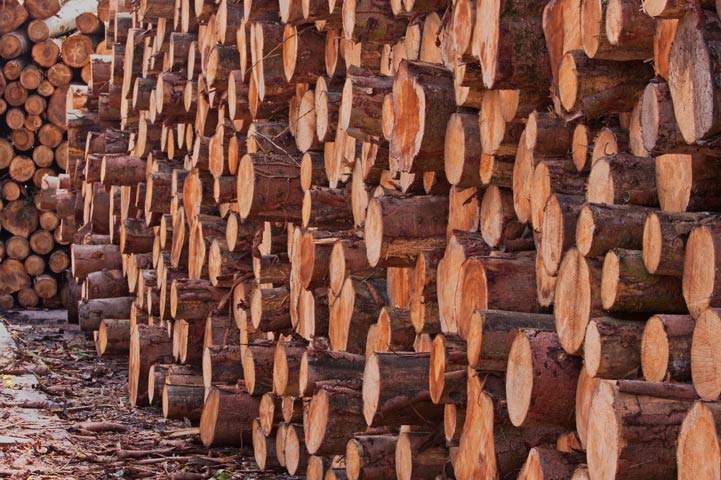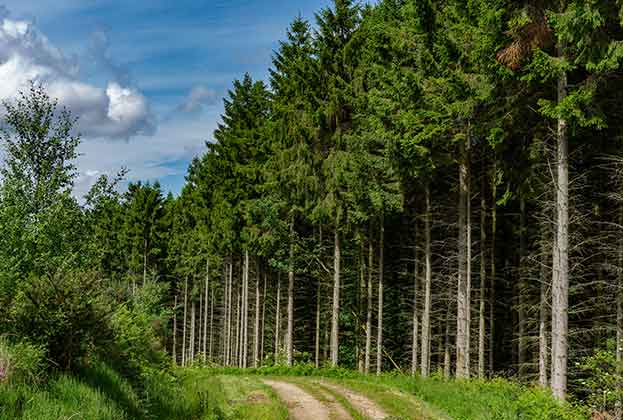The value of the UK market has increased with a significant jump in average values
Our research on the UK commercial forestry market is based on our database of all mainstream forest sales over 20 hectares in area and, where we are aware, off-market and private transactions.
Market area and value
The chart below illustrates that since 2011, there has been strong growth in the total value of the forestry investment market. This correlates with society’s accelerated interest in sustainability over recent years and the knowledge that trees and managed forests play an important role in reducing carbon.
The value of the UK forestry investment market rose significantly to £262.7 million during the 2021 forest year (1 October to 30 September 2021). This represents a 23% rise in the overall sales value compared to 2020. Interestingly, the number of gross hectares sold fell -22% to around 17,700 hectares during the 2021 forest year (chart above), but is in line with the medium-term average of 18,000 hectares. Within this market, there was for the second year a high proportion of off-market activity, with deals based on verified valuations increasingly common. Our 2021 Spotlight on the UK Forestry market reported a rise in off-market sales compared to publicly marketed properties over the last few years. During the 2021 forest year at least 28% of sales were privately marketed. This compares to 32% in 2020 and an average of 14% over the previous four years.
Average forest values
Our autumn 2021 Market in Minutes publication on commercial forestry reported record-breaking prices for the 2021 forest year. Further research, data validation and analysis of the sales data confirm this, with the average gross value increasing by 39% to just over £15,000 per hectare. Within the properties sold during 2021, the average price per net productive (conifer) hectare rose by an astonishing 61% to £23,720. The relationship between the value of the total (gross) forest area and the productive tree stocked area, capable of producing a crop of timber is important. The unproductive area has historically received a relatively low and fairly constant value, with the investment performance driven by the value of the productive area.
The chart below illustrates a widening gap in the price of a net productive hectare compared to the price of a gross hectare. During the 2021 forest year, the difference was 55%, which compares to an average of 34% difference in the previous 10 years. This is a result of very strong unit pricing for conifer stands, especially for mid-rotation timber, where there is a strong expectation of considerably better timber pricing as the demand for low carbon homes and timber utilisation in construction manifests over the next 20 years.
The size of the productive area influences forest values. Anecdotal evidence suggests current forest design guidance is compressing productive areas and this will impact future potential, both in terms of productive capacity and capital value. As highlighted in Planning for long-term success, closer analysis of the data suggests, on average, the older the forest, the larger the productive area (see table below).
Regional performance
The value of a forest property is dependent on a growing number of regional variables
Although every forest property is unique and average values do hide a growing number of local variations – location, access, species, age and timber volume – average values provide a useful basis for trend and comparable analysis.
NORTH SCOTLAND
Average forestry values across North Scotland are historically lower than more southerly areas of Scotland, England and Wales. This is due to the location and physical characteristics of the region. North Scotland is typically viewed as returning a lower income from the timber produced. However, in more recent years, as the demand for forestry has accelerated, buyers are seeing the potential opportunity to improve the performance of traditionally less popular properties through new technology, improved species and management techniques. Following a year of strong market activity during 2020, the area reported the second largest market share (32%) across Scotland, England and Wales and average values rose by 41% to £10,261 per hectare during the 2021 forest year.
CENTRAL SCOTLAND
In line with recent years, market activity here remained strong with average values rising by 29% to £23,476. Central Scotland returned the largest market share of 33%, with just over 5,800 hectares sold. Interestingly, according to our sales database, in terms of the most hectares sold across Scotland, England and Wales, Central Scotland has been positioned first or second every year throughout the past 10 years, a reflection of the large scale of some of the property in this region.
SOUTH SCOTLAND
Our research indicates the number of hectares sold during the 2021 forest year across South Scotland fell by -8% to 3,556 hectares. Prior to 2016, the highest average price across Scotland, England and Wales was South Scotland. Since 2016 values in England and Wales have risen to the top spot, with the difference in price widening to £6,000 per hectare on average in 2018. However, during the 2021 forest year, the average price per productive hectare in South Scotland doubled on the back of some very strong sales of large scale, mixed-age commercial forests, to £29,163 per hectare, narrowing the price gap between the two regions to just over £800.
ENGLAND AND WALES
The average price of commercial forestry traded in England and Wales is just under £30,000 per hectare. This equates to a 90% increase on the 2020 forest year. The number of forest hectares transacted in England and Wales fell by around 1,000 hectares to 2,677 hectares during 2021, and capital prices were very strong, correlating to exceptional timber prices, especially in Wales.
Update on timber market 2022
The conflict in Ukraine is having an impact on forestry and woodland, immediately through the rapid rise in the price of fuel, but also due to the importance of Russia as a timber exporter. On top of extensive winter storm damage and a continued lethargy in consenting to new planting projects, the current season is proving to be a tricky one. To put it into context, more timber was felled by storms in the UK this winter than we managed to plant last season. Russia is a major exporter of timber, including paper and wood pellets, worth over $12bn in 2021 (Source: Wood Resources International LLC), so with western export markets shut off, timber prices are likely to remain high. It is unknown whether major economies in the east will absorb Russian supply. There is also a strong possibility that post-conflict rebuilding efforts will be in timber, fuelling long-term demand. The extent to which major economies in the west struggle economically will impact on the outlook, but commodity-based investments are likely to do well. We are for instance already seeing anecdotal evidence of increased demand for firewood for next winter to counter high energy prices in rural areas.

Read the articles within The Forestry Market below.
.jpg)
